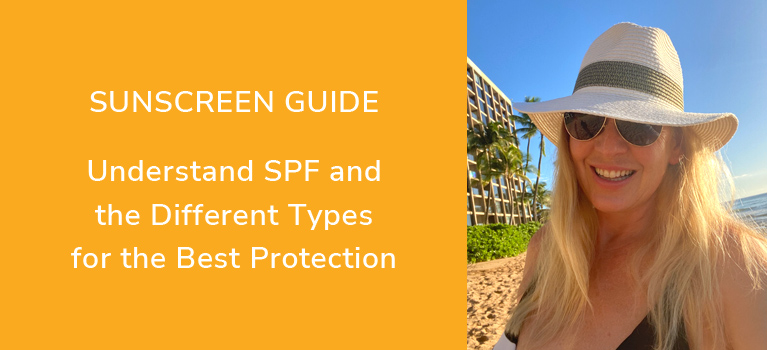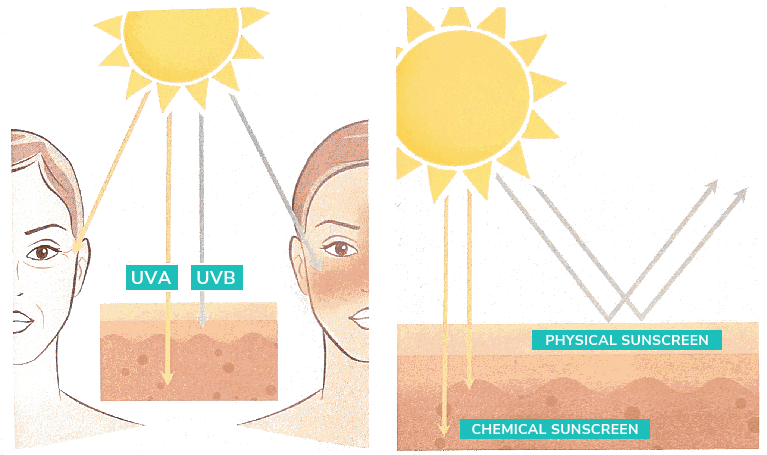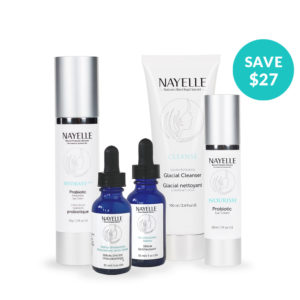
How-to Guide: Choose the Best Sunscreen and Understand SPF to Protect Your Skin from Sun Damage
Enjoying the sun is a great way to relax and rejuvenate the soul, but it is essential to protect your skin from the harmful effects of the sun’s ultraviolet (UV) rays.
Sunburn, sunspots, wrinkles, and the reduction of collagen are all signs of premature aging caused by the sun’s rays.
One of the best ways to protect your face from the sun is by using sunscreen, but not all sunscreens are created equal.
In today’s blog, I will explain the benefits of physical sunscreen block versus chemical sunscreen, and how to understand the SPF. I will also provide tips on how to use sunscreen correctly to provide maximum protection.
Studies Show Sunscreen Keeps Us Looking Younger
One of many studies, a study published in the Annals of Internal Medicine, found that using sunscreen regularly can prevent premature aging caused by the sun’s rays.
The study followed 900 participants over four and a half years and found that those who used sunscreen daily had 24% less skin aging than those who only used sunscreen intermittently.

Physical vs Chemical Sunscreen
The two types of sunscreens available on the market are physical sunscreen block and chemical sunscreen.
These are the most important differences:
- Physical sunscreen contains mineral ingredients like zinc oxide and titanium dioxide, which act as a shield and reflect UV rays away and prevent it from entering the skin.
- Chemical sunscreens contain organic compounds like avobenzone and oxybenzone that absorb UV rays and convert them into heat. This is all happening inside the skin once the UV rays penetrate it.
Both types of sunscreens are effective at protecting the skin from the sun’s harmful rays, but there are some key differences between them.

Physical Sunscreen – Pros & Cons
One of the main benefits of a physical sunscreen is that it provides broad-spectrum protection from both UVA and UVB rays, but they used to be thick and hard to apply.
Physical sunscreen provides the ultimate protection, hence why you see those exposed to extreme sun, like mountaineers and surfers use it. The ‘white cast’ appearance on the face was the downside.
The good news is, now with the recent formulations, you won’t look like Casper the Ghost to be fully protected.
In addition to providing the best protection, physical sunscreen provides this protection without harmful chemicals that add to one’s toxic load. They are also gentle on the skin making it a better option for people with sensitive skin, like many of our Nayelle customers.
We know the importance of providing products that use natural, clean ingredients and are gentle on the skin.
Chemical Sunscreens – Pros & Cons
Chemical sunscreens, on the other hand, tend to be more lightweight and easier to apply, making them a popular choice for daily use.
However, some chemical ingredients in sunscreens have been linked to hormonal disruptions and other health concerns, and they can also cause irritation.
Harmful chemicals often found in these sunscreens – oxybenzone, octinoxate, homosalate, octisalate, octocrylene, and avobenzone – many of which are endocrine disruptors:
- Endocrine disruptors are scary because they’re most harmful in small doses, as they mimic the hormones that our bodies create daily and can interfere with everything from our reproductive systems to our metabolism.
- They are particularly bad for children whose systems are rapidly developing.
What Does the SPF Number Mean?
SPF stands for “sun protection factor” and there is a popular misconception that SPF relates to time of solar exposure. Many believe that if they usually get sunburn in 10 minutes then an SPF 30 sunscreen will protect them 30 times longer (300 minutes) without getting sunburn.
This is not true! SPF is not directly related to time of solar exposure but to amount of solar exposure.
While more time in the sun eventually leads to a bigger amount of solar exposure, there are many other important factors that determine how much amount of solar energy are you getting exposed to:
- Your skin type – in general, fair-skinned people will absorb more solar energy than dark-skinned.
- Time of day – you will be exposed to much bigger amounts of solar energy at midday than at 9am or 5pm.
- Location – solar intensity is greater the closer to the Equator, so being outdoors in Los Angeles, California or Phoenix, Arizona will expose you to more solar energy than being outdoors in Canada at the same time of day and for the same amount of time.
When to Apply and How Often to Reapply
With all sunscreens, it is best practice to apply them 15-30 minutes before going outside to give it time to absorb into the skin fully.
How often to reapply? This is related to the SPF number we discussed earlier.
As a guideline, reapply any sunscreen at least once in 2 hours. In general, the lower the SPF number, the more frequently you will have to reapply your sunscreen for maximum protection. The higher the number, the less often.
And remember to reapply it more often if you are doing sports and sweating, or activities such as swimming. These are wearing off the sunscreen faster.
Correct Amount to Get Good Coverage
To ensure you are using your sunscreen to provide enough coverage, it is recommended to use at least a nickel-sized amount (almost an inch in diameter) of sunscreen for your face and neck. But apply as much as needed as some sunscreens spread better than others.
Don’t forget to apply sunscreen to your ears, lips, and the back of your neck if you have short hair or are wearing a ponytail.
Mineral Sunscreens Checklist
Even in the mineral sunscreen category, it’s good to do your due diligence and check they have these requirements:
Broad-Spectrum: This is important, as it means that the sunscreen blocks both UVA and UVB rays.
Active Ingredients: Mineral sunscreens will only list zinc oxide and/or titanium dioxide. Be wary of the term “mineral-based,” which often means zinc oxide and/or titanium dioxide has been mixed with chemical sunscreen. The sunscreen options provided below are mineral-only.
Water Resistance: A sunscreen can claim to be water-resistant only if it has undergone a 40- or 80-minute test. If water resistance is not stated clearly on the label, the sunscreen will most likely wash or sweat off. Okay for use for casual days but definitely choose a water resistant sunscreen for high intensity and water sports as you need to keep it from wiping off easily.
Red Flags: Even if the active ingredients are mineral, make sure that the formula is not otherwise loaded with toxic ingredients. Red flags include phthalates, sodium laureth sulfate, fragrance, and anything ending in “-paraben.”
The Sunscreens We Recommend
Below are a list of face sunscreens free of the ‘red flag’ ingredients. In addition, they look great (no white cast), they feel particularly luxurious and go on like a dream:
- Jan Marnini cream SPF 30 or SPF 45 Tinted
- Jane Iridale dry powder face sunscreen SPF 30
- Grown Alchemist Natural Hydrating Sunscreen cream SPF 30
Now, Go and Have Fun
So yes, have fun in the sun but remember, protecting your face from the sun is essential for maintaining healthy and youthful-looking skin. Not to mention the importance of protecting your skin from skin cancer.
Physical sunscreen block provides broad-spectrum protection without the use of toxic chemicals. It’s also less likely to cause skin irritation, making it a better option for people with sensitive skin.
Stay tuned for next week’s newsletter that will announce the new sunscreens in our store along with a little surprise for you all.
Take care and hope you have a beautiful day!
Tanya Moss

